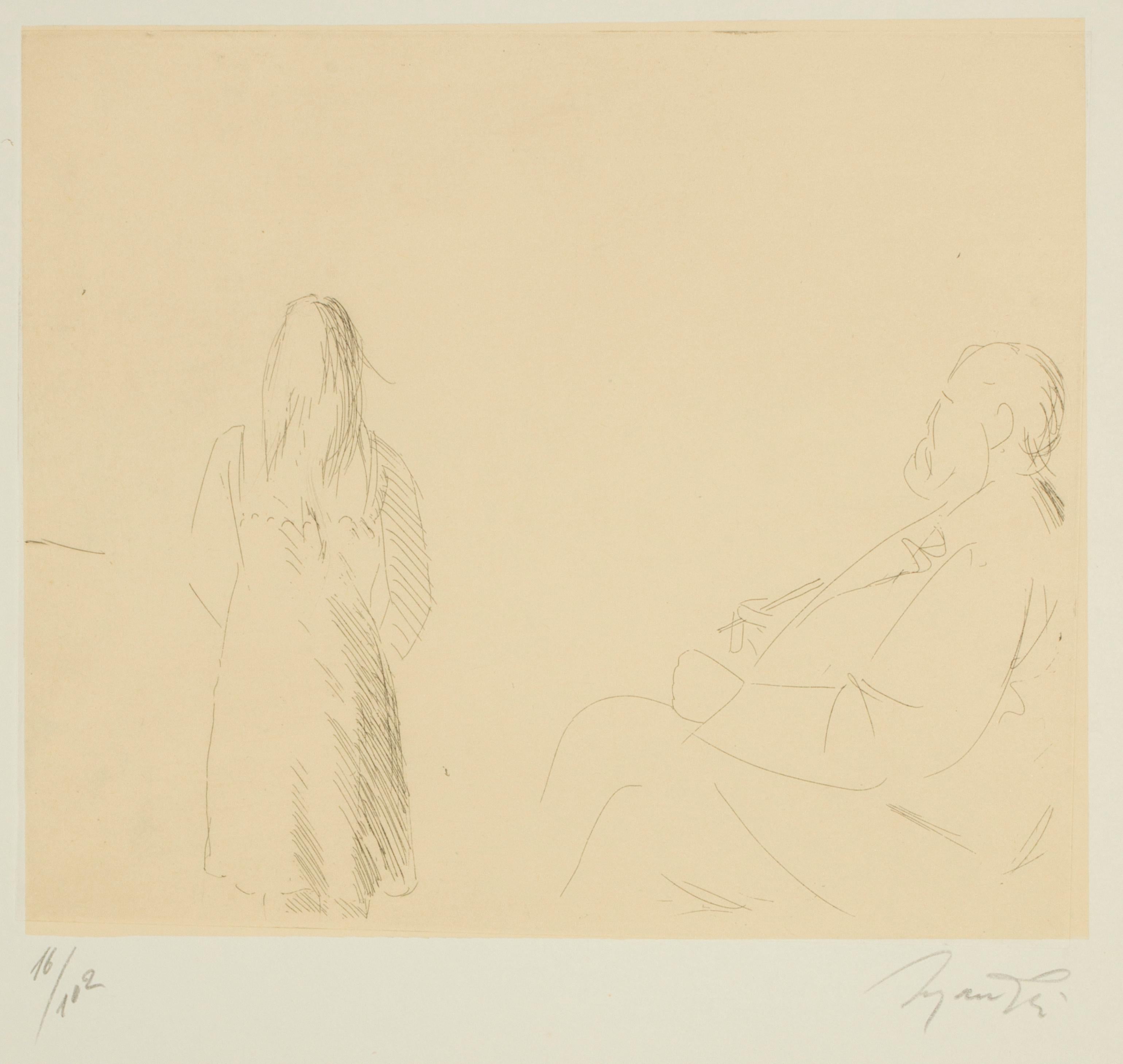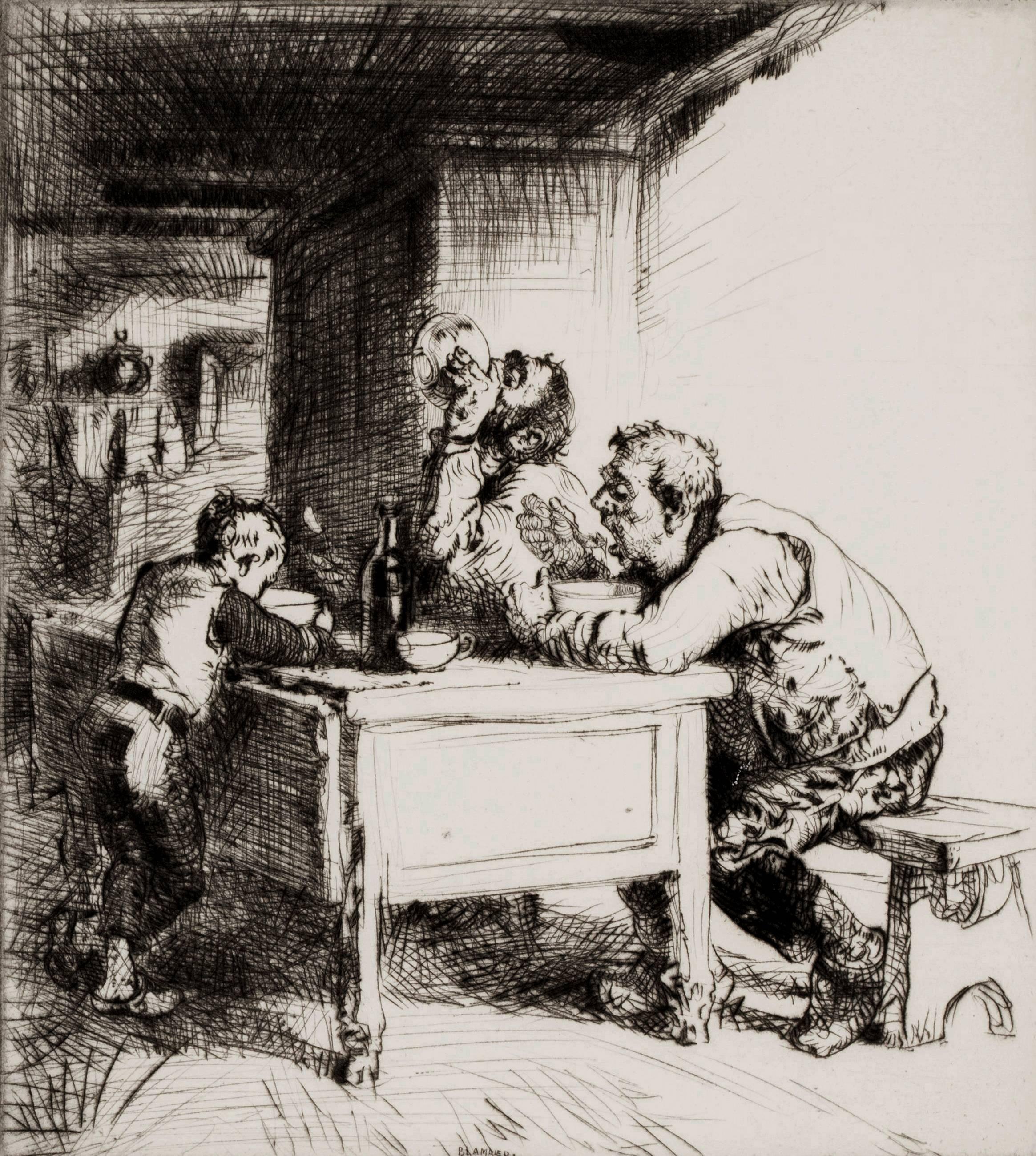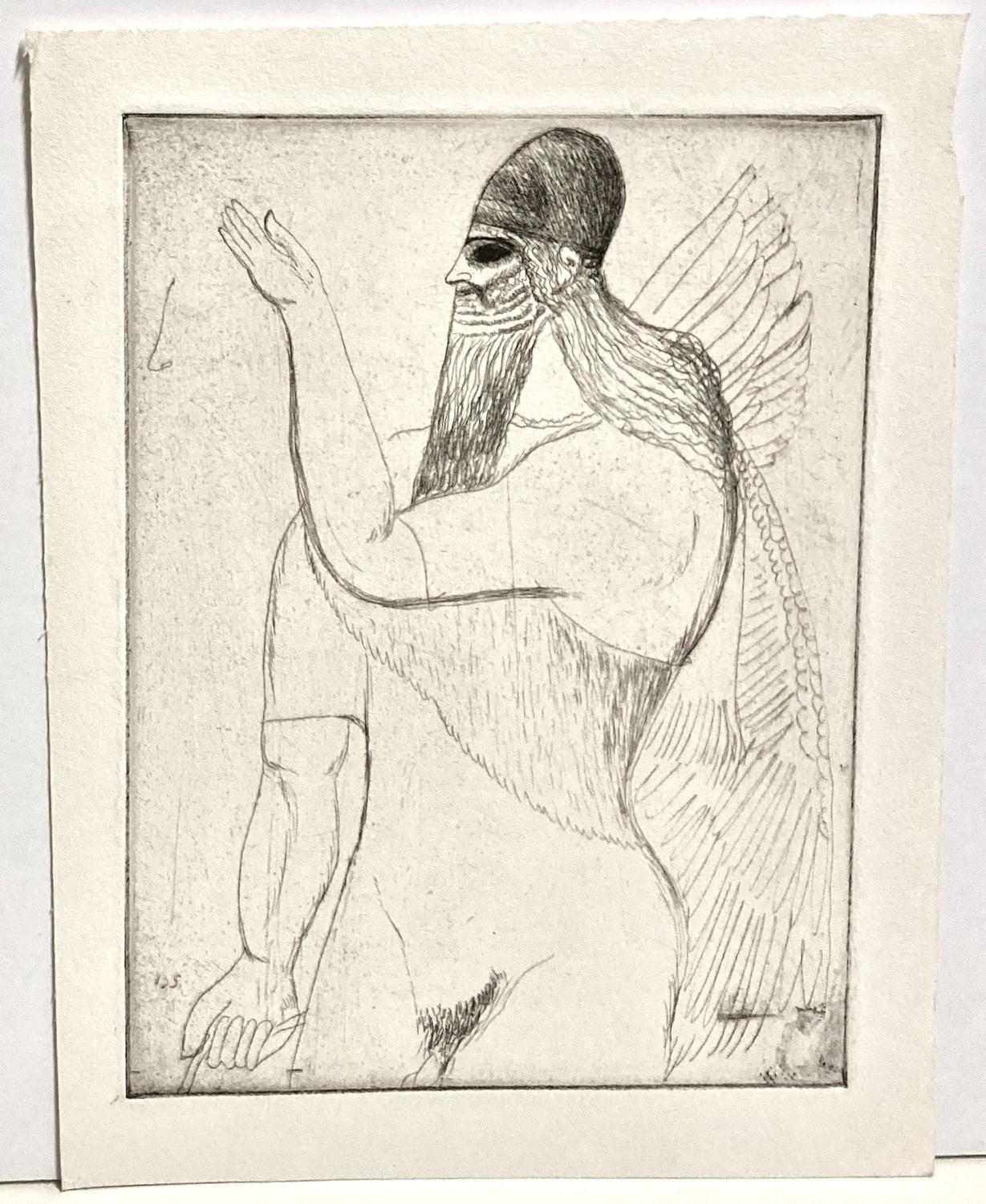Want more images or videos?
Request additional images or videos from the seller
1 of 2
Sir David Young Cameron, R.A.The Smithy1896
1896
About the Item
A warm composition, in theme and tone; the creaky timber interior of a 19th century Scottish blacksmith's shop.
Etching and drypoint on cream laid Japan paper, 8 x 10 inches (202 x 253 mm), full margins. Signed and titled in pencil, lower margin. Third state (of 3). A dark and inky impression with rich burr, and with all the fine lines printing clearly. Minor handling wear, and soft light surfact soiling, consistent with age.
[Rinder 234 iii/iii]
The son of a clergyman, Sir David Young Cameron was born in Glasgow in 1865. After a brief and unhappy dalliance in the fields of business and law, Cameron began attending the prestigious Glasgow School of the Arts in 1881, and later the Edinburgh School of the Arts. At first associated with the Glasgow Boys (John Lavery, Joseph Crawhall and James Guthrie), Young gained notoriety as an etcher, and by the 1890s he was internationally recognized, and had been elected to the Royal Society of Painter-Etchers.
In 1899, having married, Cameron and his wife moved to the Scottish Highlands, where he switched his focus from interior scenes to architectural and landscape compositions. His feathery line etching technique married beautifully with the dramatic landscape of the Highlands, and his compositions are delicate studies of light and shadow that capture both the softness and the severity of the atmospheric skies, rocky outcroppings, and mossy ruins that surrounded him. Many of these compositions focus on a central shadow, or an emanating light, and show the influence of Francis Seymour Haden, James McNeil Whistler, and Charles Meryon.
In 1901 Cameron joined the International Society of Sculptors, Painters and Gravers, an organization founded in 1898 by Whistler. He had exhibited with the society from the date of its inception, and later served on its council. In 1917 Cameron was commissioned by the Canadian government to serve as the Official War Artist. Among the numerous prestigious appointments that Cameron held during the course of his career, he was elected Trustee of the Tate Gallery and the Scottish National Gallery from 1921 to 1927, and was Knighted in 1924. He was given the title of King's Painter and Limner in 1933.
Cameron produced over 500 prints, primarily etchings and drypoints during his life, and his work is represented in the permanent collections of the Tate Gallery, the British Museum, the National Gallery of Scotland, the National Gallery of Canada, the Metropolitan Museum of Art, and the Art Institute of Chicago. Cameron died in Perth, Scotland, in 1945.
- Creator:Sir David Young Cameron, R.A. (1865 - 1945, British)
- Creation Year:1896
- Dimensions:Height: 8 in (20.32 cm)Width: 10 in (25.4 cm)
- Medium:
- Movement & Style:
- Period:
- Condition:
- Gallery Location:Middletown, NY
- Reference Number:
Sir David Young Cameron, R.A.
Scottish painter, etcher, and draughtsman, born in Glasgow, the son of a clergyman. He abandoned brief unhappy careers in commerce and law to study at *Glasgow School of Art and the Royal Scottish Academy in Edinburgh. Most of his work consisted of landscapes (especially scenes of mountains) and architectural views, and he is best known for his etchings of buildings, including Gothic churches on the Continent: ”rich and sombre works" with which he established a reputation as one of the outstanding printmakers of the day.
About the Seller
5.0
Vetted Seller
These experienced sellers undergo a comprehensive evaluation by our team of in-house experts.
Established in 2004
1stDibs seller since 2022
30 sales on 1stDibs
Typical response time: 9 hours
- ShippingRetrieving quote...Ships From: Middletown, NY
- Return PolicyA return for this item may be initiated within 30 days of delivery.
More From This SellerView All
- The Grolier Club Library (Sketch), Demonstration PrintBy John Taylor ArmsLocated in Middletown, NYEtching on light yellow cream laid paper with deckle edges, full margins. Inscribed in the image "Library of the Grolier Club, Demonstration Plate, Drawn, Etched and Printed in a Li...Category
Mid-20th Century American Modern Interior Prints
MaterialsLaid Paper, Etching
- La Messe (The Mass), after CaravaggioLocated in Middletown, NYChiaroscuro woodcut with underlying engraving on cream laid paper, printed from two blocks in brown and olive. 10 1/4 x 12 3/4 inches (260 x 321 mm) (plate), full margins with the text printing clearly below in black ink. In very good condition with scattered surface soiling and several minor flecks of light discoloration in the margins, especially in the area of the lower right corner, well outside of image area. Unobtrusive notations in pencil in the margin and on the verso. All condition issues are consistent with age. After a drawing of the same title by Polidoro da Caravaggio...Category
Mid-18th Century Old Masters Figurative Prints
MaterialsEngraving, Laid Paper, Woodcut
- Points of Departure II: Nijinsky VariationsBy Peter MiltonLocated in Middletown, NYPoints of Departure II: Nijinsky Variations Robert E. Townsend, 1996 Resist-ground etching and engraving on BFK-Rives paper, 24 x 38 inches (618 x 965 mm), full margins. Signed, ti...Category
1990s American Modern Figurative Prints
MaterialsEtching, Engraving
- Interiors VII: The Train from MunichBy Peter MiltonLocated in Middletown, NYInteriors VII: The Train from Munich Robert E. Townsend, 1991. Resist ground etching and engraving with hand refinement in charcoal, pencil, stabilo, and eraser on BFK Rives white wove paper, 20 x 36 inches (507 x 914 mm), full margins. Signed, titled, dated and numbered 51/175 by the artist in pencil, lower margin. A brilliant, inky impression with luminous light and gradient tones. In excellent condition with one extremely minor and superficial spot of light tan adhesive residue on the verso, unobtrusive and not visible on the recto, with no other visible defects. With the blind stamp of the printer, Robert E. Townsend in the lower left margin. An especially fine impression in superb condition. [Milton 113]. When asked about this work in particular, Milton expressed that his favorite images were his darkest images, in theme, mood, and in ink. Milton, who has said that his work is infused with a postmodern awareness of the past, has focused here in a deeply personal way on a segment of history that continues to haunt us all. The work, published in 1991, evokes one of the darkest periods of European history, the eroding and erasing of European culture under fascism, and the eventual total loss of humanity. The Train from Munich is an especially relevant and emotional work for Milton, who created the piece for his wife, Edith, who escaped Munich in 1939 as a child on the fabled Kinderstransport. The Kinderstransport was a desperate rescue effort on the part of the British government to save as many Jewish children as possible by railway before borders closed on the precipice of the Second World War. Children left their parents behind, and boarded the trains alone, leaving the impending doom of Nazi Germany, they arrived in Great Britain as refugees. More than 10,000 children escaped the holocaust via the Kinderstransport. In Train from Munich, the image itself holds an almost immeasurable amount of symbolism; each inch of the matrix is a successful effort to confront this history in a way that is poignant through a series of motifs. We see the Café disappearing into a ghostlike memory of the past, an allegory to the disintegration of culture, while through the windows we can see a rampant, snarling dog; a portrait of Hitler's shepherd, Blondi. Blondi isn't the only notable figure in the composition. Milton has pointed out that the fading figure of the doorman at the Hotel Metropole is modeled after the artist and intellectual Marcel Duchamp, and the face of the young girl peering...Category
1990s American Modern Interior Prints
MaterialsABS, Charcoal, Engraving, Etching
- Interiors I: Family Reunion — A penetrating scene with a hidden homage to EadweaBy Peter MiltonLocated in Middletown, NYInteriors I: Family Reunion 1984 Resist ground etching and engraving on BFK Rives wove paper, 20 x 36 inches (501 x 913 mm), full margins. Signed, titled, dated and numbered 49/175 in pencil, lower margin. In excellent condition with minor mat tone. A luminous, rich, and well-inked impression of this haunting image, with astonishing detail and depth. Framed handsomely under museum grade glass with archival materials in a solid wood frame with silver finish. [Milton 107] Intended to be a stand alone image in its inception, Family Reunion ended up spawning seven additional images, and became a sort of Primo Pensiero in the sprawling, masterpiece suite now known as Interiors. The suite took eight years to complete, and consists of works of varying format, psychological intensity, and subject matter. The thematic darkness in the eight images waxes and wanes, and Milton intentionally included several interlude works to lighten the tension he felt while composing several of the darker images. The first two in the series, Family Reunion, and Hotel Paradise Café, were meant to be companion pieces. The equilibrium of each composition is anchored on a central brooding figure; a man (perhaps based on a Thomas Eakins portrait of the American anthropologist Frank Hamilton...Category
1980s American Modern Figurative Prints
MaterialsEtching, Engraving
- Synagogue Duke's Palace Houndsditch by Th. Sunderland after Pugin & RowlandsonBy Thomas RowlandsonLocated in Middletown, NYA faithful architectural rendering of the earliest Ashkenazi synagogue constructed in London; built about 1690, and subsequently destroyed in the Blitz, 1941. London: Rudolph Ackerm...Category
Early 19th Century English School Interior Prints
MaterialsAquatint, Engraving, Handmade Paper
You May Also Like
- Painter and ModelBy Giacomo ManzúLocated in Roma, ITPainter and Model is an original artwork realized by Giacomo Manzù in 1964. Hand signed on the lower right margin. Numbered on the lower left. Edition of 102 copies (16/102), etch...Category
1960s Modern Figurative Prints
MaterialsDrypoint, Etching
- PoliticsBy Edmund BlampiedLocated in Storrs, CTPolitics (Tonnere de Brest). 1926. Drypoint. Appleby 108. 7 x 9 (sheet 10 1/2 x 15 1/2). A rich impression printed on cream wove paper with full margins. Illustrated: Salaman, Modern...Category
Early 20th Century Modern Figurative Prints
MaterialsDrypoint, Etching
- The LetterBy Edmund BlampiedLocated in Storrs, CTThe Letter. 1921. Drypoint. Appleby 107. 7 x 9 3/8 (sheet 10 1/2 x 15 7/16). Edition 100. Illustrated: Fine Prints of the Year, 1925; Salaman, Modern Masters of Etching: Edmund Blamp...Category
Early 20th Century Modern Figurative Prints
MaterialsDrypoint, Etching
- France at her FurnacesBy James McBeyLocated in Storrs, CT1917. Etching. Hardie 175. 8 x 15 (sheet 10 1/8 x 16 15/16). Edition 76. Slight mat line; otherwise excellent condition. A rich impression printed on antique laid paper with full m...Category
1910s Modern Interior Prints
MaterialsDrypoint, Etching
- SoupBy Edmund BlampiedLocated in Storrs, CTSoup. 1920. Drypoint. Appleby 65. 9 x 8 1/8 (sheet 15 x 11 9/16). Edition 100. Illlustrated: Print Collector's Quarterly 13 (1926): 85. Signed in pencil. Edmund Blampied was a painter, etcher, lithographer and sculptor. Born in 1886 to a family of three boys in St. Martin, Jersey, Blampied became interested in drawing at an early age. After visiting the studio of John Helier Lander in 1899, Blampied decided to make a career as an artist. In 1903 he went to London to attend Lambeth Art School, where he studied etching under Walter Seymour. In 1905, he joined the Daily Chronicle as an artist. In that year he was awarded a scholarship to Bolt Court Scool of Photo-engraving and Lithography. In 1912 he left the Chronicle and established his own studio. He earned a living by illustrating novels and short stories. In 1913, he had his first exhibition at the Leicester Gallery in London. The following year he married Marianne Van Abbé. During the 1920's, he became a member of the Royal Society of Painter-Etchers and Engravers. During the 1920s Blampied became a member of the Royal Society of Painters-Etchers and Engravers and exhibited in London to critical acclaim. He produced a folio of comic drawings in the 1930s which was published in New York in 1934 and another that was published in London in 1936. The Keeper of Prints and Drawings at the British Museum published a mongraph on his work. His London exhibitions were highly successful. In 1938, he moved to Bulwarks, St.Aubin in Jersey, but at the onset of the Occupation, had to relocate to Route Orange, St. Brelade. remained there throughout World War II during the German Occupation, despite the fact that his wife was Jewish. During the Occupation he designed bank...Category
1920s Modern Figurative Prints
MaterialsDrypoint, Etching
- Bernard Sanders, (Mesopotamian Figure)Located in New York, NYClearly Sanders was looking at ancient Mesopotamian figures. Even the elaborate feathered wings can be found there -- made about 5000 years ago! There's an initial 'S' in the plate...Category
Early 20th Century American Modern Interior Prints
MaterialsEtching, Drypoint
Recently Viewed
View AllMore Ways To Browse
Vintage Interior Light
Shop Interiors
Business Interiors
The Vintage Modern Shop
19th Century Scotland
Vintage Interior Shop
Vintage Interior Shops
Japanese Vintage Shop
Law Etchings
Canadian Rockies
Rockies Canadian
King Charles Iii
Canadian Paper 19th
Blacksmith Sign
Vintage Edinburgh Prints
Ruins Pencil
Etchings By Whistler
James Whistler Etching




